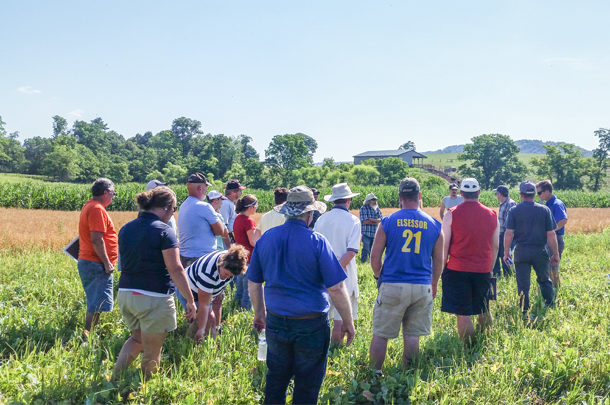Grazing cattle on alternative forages during forage shortage periods helps fend off the ill effects of a summer slump and allows the producer to save the hay they would have to feed for later in the year. Many producers already plant alternative forages as a remedy for summer slump, but alternative forages can be optimized even further if they are planned as part of a set rotation.
The Double B Grain Farm in McAlisterville, Pennsylvania, hosted a field day, facilitated by the Pennsylvania State University extension, to show how alternative forages planned into their regular crop rotation are benefiting their operation.
Double B Grain Farm is a fourth-generation family-owned partnership. Doug Brubaker is the general manager of the farm, and his sons Eric, Mike and Cody oversee different aspects of the farm. The farm includes 400 acres of farmland and pasture. The Brubakers currently run 45 Limousin and Limousin-Angus cross cattle, and produce corn, soybeans, hay, spelt wheat and broiler chickens.
“I’ve been working with Penn State on trying some alternative ways to graze cattle,” Doug Brubaker says. “On cropland, we put pearl millet out so we have a summer graze.”
Pearl millet isn’t the only alternative crop the Brubakers turn to. In addition to their main crops of corn and soybeans, the Brubakers also raise spelt wheat. Spelt wheat is a variety of wheat that is supposed to be more nutritious than common wheat and is largely marketed as a health food.
Last year was the first year the Brubakers planted pearl millet. This year, the Brubakers tried planting rape along with pearl millet. Brubaker says the rape actually performed better than the pearl millet.
The growing conditions this year were not ideal for pearl millet. “We’re having a terrible drought right now,” Brubaker says. “Last year, we did pearl millet and it did really well; this year, with the drought, it didn’t do so well.”
Despite the decreased production this year, the pearl millet and rape have still managed to perform their purpose – compensate for the summer slump. “Last year it wasn’t a dry year, but for about a three-week period it was, and that pearl millet just fit in perfect in that period where it was dry,” Brubaker says. “We normally would have probably had to feed bales, but we didn’t feed any.”
Brubaker says the cattle adjusted quickly and easily to grazing on pearl millet. It took longer for them to adapt to eating rape. “They were in probably four days before they really started eating it,” Brubaker says. “Once they learned what it was, they really liked it.”
Brubaker says in general, the alternative crops seem to be economically viable. He’s had mixed results, but since it’s only the second year for millet and the first for rape, a firm conclusion can’t be formed yet. Brubaker says alternative forages are a good idea because they allow you to get more out of your land. “Especially after corn and soybeans, you can actually get the second crop off. Whether you graze it or mow it and wrap it, you’re getting two crops off in one year,” he says. “You can graze it, on a good year, three or four times.”
The choice of alternative forage may change according to region and preference, but they are a solid resource for overcoming summer slump and should, like every other resource on a farm, be used to the fullest advantage. ![]()
PHOTO: The Brubakers hosted a grazing workshop at their farm on July 27, 2016, where they discussed different grazing management practices, including alternative forages. Photo by Elizabeth Bosak.










